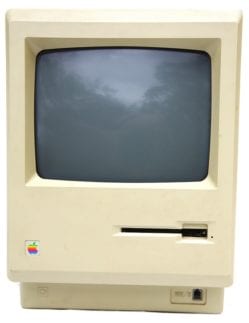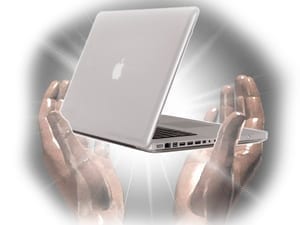OWC Senior Software Engineer, George Rath, shares his story about how a Mac 512K he pieced together in a refugee camp changed his life after fleeing Communist-controlled Hungary.

At the age of 26-27, I used to be a known Russian hacker living in Hungary. The original meaning of the word “hacker” was a person who could fix model railroad electronics and firmware for model railroad shows. Later it was used for any kind of hardware/software fix, installation, software workarounds, etc.
The word “hacking,” as it is used today, pretty much has nothing to do with what it used to be – until around 1990. Today the word “hacker” refers to what used to be called a “cracker” – a bad guy involved in computer crime. My first “hack” was when I learned to read punch tapes by looking at the holes.
My daytime activity was working as a programmer for the Ministry of the Industry in Hungary. I wasn’t really happy with my daytime job, so in the evenings, I was hacking ROMs of Western Digital controllers to match them with the MFM hard drives sold at that time. These weren’t something you could buy easily, even in the States. And everything in Hungary was contraband. For example, printers could be used for political dissent.
In 1986, the price of drives, and these were 10–40MB drives was around $250 to $300. A typical salary in East Europe was $50 – $150, and tech equipment had 100% to 200% duty charges. So it is easy to see how finding hardware and software workarounds became the norm. A typical hardware/software hacker would earn money by adapting these expensive hard drives to the expensive controllers, and work on some administration database projects, too.
When my wife got into political problems with the Communists, who were in control at the time, we escaped Hungary to West Germany. In Germany, for the first few months, we had no work permit, and I had to do something. My IBM PC wasn’t with me, so I looked for other interesting objects. I found a used Mac 512K, with no hard drive, and a lot of issues. I spent time learning how to expand the hard drive possibilities, add SCSI interface, and so on, and in a few months, I had a relatively up-to-date Mac workstation in the refugee camp! No one believed it – that this could be true.

In 1993 we left Germany because I was hired in the U.S. – as a Mac OS specialist! Until my time in the German refugee camp in 1988, I had not even seen a Mac. That was 30 years ago, but it determined all my further activity, up to today.
There is a funny side, too: the cheapskate mentality of the refugee camp is still in my brain; I probably will never get rid of it. I still enjoy fiddling around with older machines and trying to fix or upgrade them. My wife is the witness of this and is the one who suffers – I still have a nice “collection” of Macs made in the last 20 years.
My original Mac 512K is sadly gone.









HEY GEORGE!
WOW – Great story & similar to my own (at least the passion part ;-)
Love all things Apple & love evangelizing for them to my PC friends (much to their annoyance I’m sure).
Stay Safe & much love <3
P.S. I’ve got an old 512 that I haven’t used in a loooong time – If you’d like it shout back at me. Can’t guarantee it works but probably could be fixed…? ;-)
hello …
could any one here help me find out ?
to get my mac book pro 2008 unibody
to work having some problem
with the efi
where it will not show any options
when trying to install a mac os 10.6.1
on an new san disk ssd 128gb
so the os would have to be on the ssd
where then the mbp would find it
and start installation
from there
so how would I formate this ssd ?
in what partion would I place
the os 10.6.1 dmg ?
etc
I am having only windows 7
and several linux pcs for doing this
but would like to save this mbp
since it would be a shame
not to …
regards fritz
Fritz
Installing from a .dmg won’t work. It’s a waste of time trying.
Plug that thing into ethernet, boot into recovery mode per instructions from Apple you will find online. They will explain how to use disk utility to check and format the drive before you install the OS.
Obviously MBP needs to power on, with a hard drive in it.
Good luck.
https://support.apple.com/en-us/HT201314
thanks rob !
we have here a lan from a dsl router
is pluging this into the mbp ok ?
then as I have been saying
I can only boot as is
then a white display is comming on
after a while it is saying
“change the hdd … for booting press any key ”
or if I boot for O options
I find the mbp to searching the ssd
having now all the stuff on it from me trying
and nothing will come of it
now … do you mean ?
that I should go online with apple
and >>>
they will go into ” recovery ” ?
because the R on the mbp will not do anything
since there may be some problem with the efi
regards fritz
Hi Fritz. I’m no Mac wizard, but I installed an SSD on my 2008 iMac with ease. If you insert the 10.6 software CD/DVD into the drive, the computer will boot off the CD to start the Mac. It will then automatically locate the SSD and install the OS, as for any conventional drive. Just follow the instructions. There are also a nice set of video tutorials on line at OWC to help get you over the humps when it comes to disassembling and reassembling your hardware. (At least that was my experience, and I’m what is known as a guy who is, “All Thumbs!” GOOD LUCK!
thanks ron
but we have no functioning super drive …
and we have here some mbp having a problem !
then a white screen will show up
then going pitch black > then gray
and then >>>
” remove hdd … to boot press any key ”
now … if I could install on the new ssd
some os what ever …
maybe just a diagnosis tool ?
then we would know what this mbp 2008 unibody
can do … and what problem it may have
like if I had some mbp working
all I would need to do
is plug his hdd into this one
and see what it will do
does any one here have any idea ?
how to get this to work …
it is such a nice machine
just to look at !
some one found it in the garbage !!!
in the original box with 2x mag power in it
but no hdd
regards fritz
Hi Fritz,
You’ve already thought of this, I’m sure, but in case you haven’t: have you tried connecting the mbp to another Mac via Firewire, USB, or Ethernet? Then run Apple’s Disc Utility (DU)form the connected remote Mac to format the drive – if DU sees the drive, which I doubt – then install the Mac OS via the Firewire/USB/Ethernet connection. I have no idea if this would or not.
Once again, GOOD LUCK!
hello ron
as I have already mentioned in my first post
I have no other mac here …
other wise it would be no problem !
and if I had a mbp …
I could just plug his hdd into the mbp
we are talking about and see what happens !
so I have been asking you >>>
is there any diagnosis tool I can use ?
to install on the ssd
with a windows or linux pc ?
formating I could with an app like gparted
but I need more to find out what problem
there is with this mbp unibody
if you here have no further idea
I will be looking in the SEs
or other forums …
regards fritz
Hi Fritz.
I have no further recommendations. I’d be interested to know how y9ou make out. Let us know please. Good luck.
A VERY interesting story. Thanks for sharing.
What a fascinating story, I didn’t know how the “hacker” word came about but he is a real OG hacker.